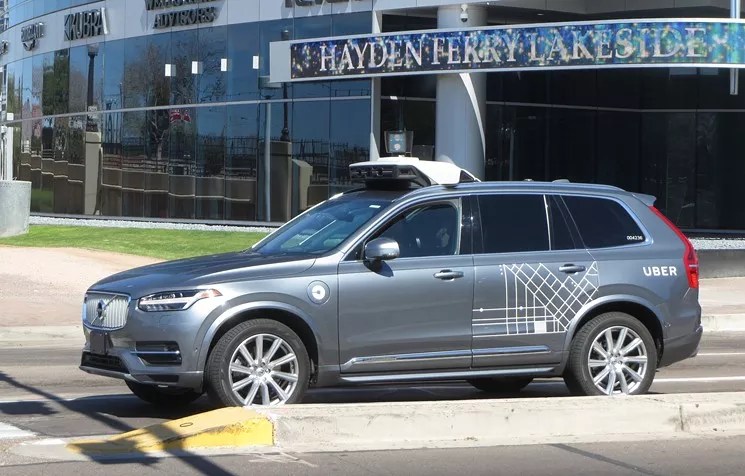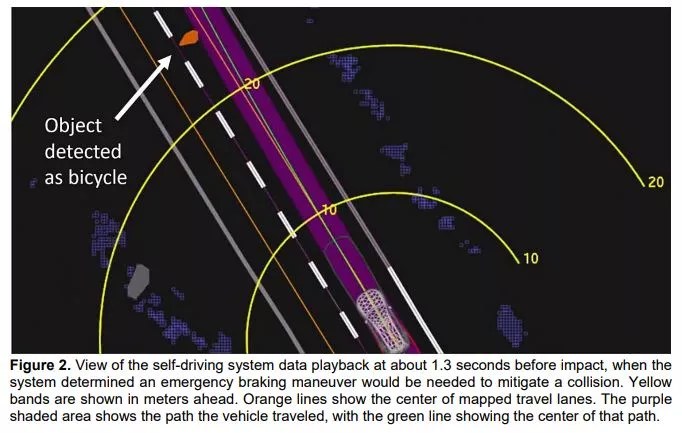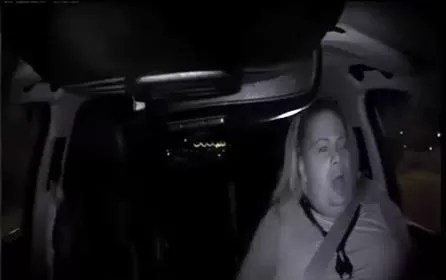
Zomblelte via Flickr

Audio By Carbonatix
A federal report on an Uber autonomous car’s fatal impact with a pedestrian in March states that Uber put all the responsibility for emergency braking on its backup drivers.
The preliminary report released on Thursday by the National Transportation Safety Board states that the Uber vehicle detected the pedestrian six seconds before impact, but was not devised to brake automatically in emergencies.
“According to Uber, the developmental self-driving system relies on an attentive operator to intervene if the system fails to perform appropriately during testing,” the report states.
Rafaela Vasquez, 44, was serving as the backup driver on the night of March 18 with the car in autonomous mode when it struck the pedestrian on Mill Avenue.
Elaine Herzberg, 49, who had been walking her bike across the street far from any crosswalk, died soon after the impact. Toxicology results showed she had methamphetamine and cannabis in her bloodstream, the report states.

NTSB
Previously released video of the car’s interior shows that Vasquez was not looking at the road in the seconds before the crash. Instead, she was looking below the dashboard, near the center console. The Volvo XC90 was traveling at 39 mph in a 45 mph zone and didn’t slow down or brake before hitting Herzberg.
Tempe police announced on Wednesday that investigators had finished their probe of the crash and submitted a report to the Maricopa County Attorney’s Office for review. Amanda Jacinto, spokeswoman for County Attorney Bill Montgomery, confirmed the office received the report but said it’s too early to comment about it.
Also on Wednesday, Uber announced that it was pulling its self-driving operation out of Arizona. The company had voluntarily stopped its Arizona program after the crash, but was also ordered to keep its cars off the street until further notice by Governor Doug Ducey. Uber said it knew that the NTSB preliminary report would be released on Thursday but that’s not related to the company’s announcement that it was pulling out of Arizona.
According to the new NTSB report, the Uber vehicle contained a “developmental self-driving system” consisting of radar, lidar, navigation sensors, a computer, and 10 cameras.
The Volvo came to Uber factory-equipped with City Safety, a high-tech collision avoidance system that provides automatic braking in emergencies and alerts for inattentive drivers. But Uber designs its self-driving cars to turn off that system when the car is in autonomous mode.
The City Safety “functions are disabled when the test vehicle is operated in computer control but are operational when the vehicle is operated in manual control,” the report states.
Vasquez took the car out at 9:14 p.m. to run an established test route, and was on her second loop at 9:58 p.m., the time of the crash. The Volvo had been in autonomous mode continuously for 19 minutes at that point, the report says.

NTSB
The vehicle was traveling at 43 mph northbound on Mill Avenue approaching Curry Road when its radar and lidar units first picked up signs of the pedestrian, the report states. This was six seconds before impact.
The software couldn’t make up its mind at first what it was detecting. It registered an unknown object, then a vehicle, then a bicycle, and tried to figure out the object’s intended path.
“At 1.3 seconds before impact, the self-driving system determined that an emergency braking maneuver was needed to mitigate a collision,” the report states. “According to Uber, emergency braking maneuvers are not enabled while the vehicle is under computer control, to reduce the potential for erratic vehicle behavior. The vehicle operator is relied on to intervene and take action. The system is not designed to alert the operator.”
In other words, it was all up to Vasquez.
The report also states that “in addition, the operator is responsible for monitoring diagnostic messages that appear on an interface in the center stack of the vehicle dash and tagging events of interest for subsequent review.”
Vasquez reportedly told Tempe police that she was “monitoring the self-driving interface” just before the crash.
However, Uber told Phoenix New Times on Thursday that backup drivers aren’t trained to look at the diagnostics while the car is in motion.
In fact, the Uber spokesperson, who asked not to be named for this article, said that backup drivers “are not required to do anything with the diagnostics.”
When Uber’s vehicles exit autonomous mode, which happens when the driver brakes, steers, or hits a special button, an audible alert sounds in the car and a message will appear on the diagnostic readout on the dash. But backup drivers are “not required to do anything with that information.”
Moreover, the spokesperson said, backup drivers not only agree to a no-cellphone policy, but “it’s clear that the operator is not to be engaging” in things other than being a fully attentive driver.
“The focus, first and foremost, is on the road ahead,” the spokesperson said. “The purpose of the vehicle operator is to closely monitor and intervene [when needed], and that absolutely includes the emergency system.”

Rafaela Vasquez is captured before or at impact.
Tempe Police
The NTSB report states that everything was working normally on the vehicle.
The widely seen interior video catches Vasquez’s surprise as she looks up and spots the woman in her lane, the nearest to the curb. Herzberg, walking the bike from left to right in front of Vasquez, was hit on the right side of the vehicle. She almost made it to the curb.
Vasquez moved the steering wheel manually less than a second before the impact, the report states, and she started braking less than a second after the impact.
Vasquez didn’t seem impaired to Tempe police, and she wasn’t tested for alcohol or drugs, the report says.
The NTSB hasn’t yet pulled the data from Vasquez’s personal or business phones, both of which were in the vehicle. Vasquez told police she hadn’t used either phone until calling 911 after the crash.
The report also states that the car’s videos “show that the pedestrian crossed in a section of roadway not directly illuminated by the roadway lighting.”
The videos may make it seem that way, but the crash site is, in fact, near two streetlights. In the video shot by ABC15 News the night of the crash, both the Volvo and Herzberg’s bicycle are located directly beneath one of the streetlights. The second streetlight is just across the street, on the west side of the street, approximately where Herzberg began crossing.
As New Times has reported, the area is much better illuminated than the crash video released in March makes it appear. Contrary to statements Tempe Police Chief Sylvia Moir gave in an exclusive interview to a newspaper from her home state, any attentive driver would likely have seen Herzberg crossing and avoided hitting her.
Michael Medina, a Tempe products liability attorney with Davis Miles McGuire Gardner PLLC said it’s possible that Vasquez could end up being cited with a traffic violation because of the lack of attentiveness to the road she displays in the crash video.
Medina, who lives in Tempe, agreed that the crash site is well-lit, relatively speaking, and that Vasquez’s familiarity with that stretch of road, where pedestrians often jaywalk, should have helped prevent an accident.
“Obviously it’s very negligent,” Medina said of Vasquez’s action before the crash. “I think she’ll be ticketed … I don’t know how far they’ll go. I don’t think it’ll be manslaughter. A lot depends on the cellphone records.”
But even if records show Vasquez was texting before the crash, he said, the potential charge “wouldn’t be as strong as if Arizona had an anti-texting-and-driving law.”
Arizona is one of three states in the nation with no such law.
While it’s still possible to get a traffic citation for hitting a pedestrian who wasn’t in a crosswalk, Herzberg’s actions will also be taken into account by prosecutors, as will Herzberg’s toxicology results, Medina said.
The Tempe lawyer, who has successfully sued car manufacturers and Bridgestone/Firestone Tires, said he’ll be interested to see the conclusion of the investigation.
“It sounds like this was a death that could have been avoided if the [City Safety] system had been in place,” he said.
Uber said it’s not assigning any blame.
“In this particular instance, it’s clear there were a series of incidents” that led to Herzberg’s death, the spokesperson said.